Everything that’s produced in the modern world has some negative effect on the environment, and the same goes for soap from the store.
However, you can make eco-friendly soap right from the confines of your own kitchen or bathroom, without taxing the environment.
You can make eco-friendly soap at home with a few different methods.
Just know going into this that it’s going to feel different from that colorful stuff in the bottle, or the processed bar that you keep on the countertop.
It can take some getting used to, but it’s far better for the environment.
Protection
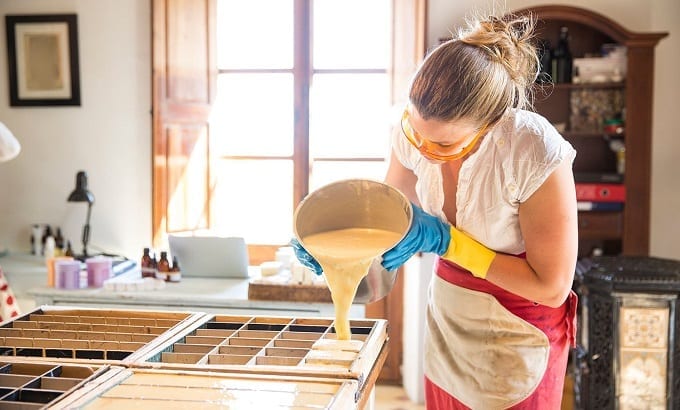
You’re going to be using something called lye for these recipes, which is a chemical compound that can be dangerous if not handled properly.
Preparing your space is absolutely critical to not only making great eco-friendly soap, but remaining completely safe throughout the process.
Get everything together in a well-ventilated area.
There is some volatility involved in any soap recipe, so being in the middle of a big space with plenty of open windows (and a few fans) will be your best bet.
You’ll want to put on rubber gloves or any other disposable gloves alternatives, some form of protective eyewear, and a face mask to avoid inhaling any fumes that rise from the lye mixture. Do not gloss over the importance of this.
Olive Oil Soap
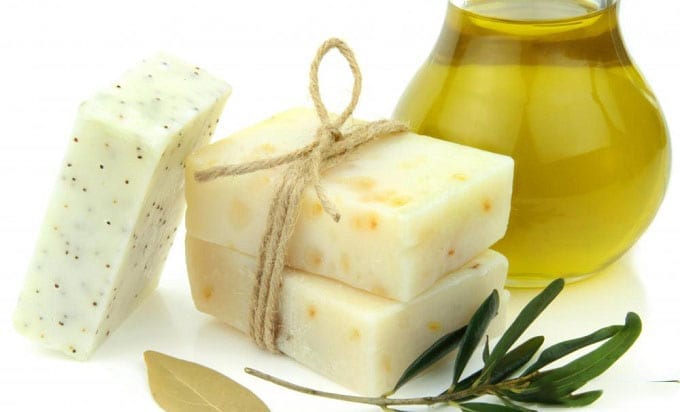
This feels slick on your skin, but soaks in and will not only clean as well as other soap, but actually hydrate your skin.
You’ll need a few things to get started:
- Extra virgin olive oil
- Caustic soda
- Purified water
- Sea salt
- Glass bowl
- A food thermometer
- High sidewall pot
- Handheld blender or whisk
- Something to mould the soap
- Tea Towel
- Surgical spirit
Step 1
Put 11 oz of water into a glass bowl. Take a teaspoon of sea salt and add it into the water. Give it a quick mix.
Step 2
Add caustic soda to the mix, give it a quick mix. A chemical reaction will result in a gas escaping from the top, which is why it’s good to have your mask and protective eyewear on.
The reaction has to settle on its own, so put this to the side until it looks clear in the bowl again.
Step 3
Measure 33 oz of olive oil, then pour it into your high sidewall cooking pot on the stove. When you’re done with this, check the temperature of your caustic soda mixture.
You want to see it drop to just below 135 F. Once it has, use your hand blender or whisk and mix the oil up while slowly pouring the caustic soda mixture into the pot.
Step 4
Mix extremely well. You want to see track marks behind it after the whisk or hand-mixer has gone through it, but don’t mix too much more past that.
You don’t want a thick paste that you can’t even get out of the pot.
Step 5
Pour the mixture into a mould of your choosing. You can use a mini loaf pan if you wish to have smaller bars of soap. Each mould should only be filled about 70% of the way up.
At this point, spray a bit of surgical spirit on top to prevent discoloration. Add the tea towel on top of the pan, and leave to sit for three days.
Step 6
Pop the soap out of the mold and cut them into smaller bars. The tricky part of this is to leave the bars in an aerated space, completely alone for an entire month.
Caustic soda isn’t kind to your skin, but once it absorbs all the oxygen from the air and the liquid from the soap, it will be completely fine to use on your skin.
Caustic soda is also called lye, which can be dangerous to work with.
That’s why we began this article by telling you to open windows and work in a well-ventilated area with plenty of personal protection.
There are other ways to make soap at home, but they require you to have first purchased non eco-friendly bar soap.
That is a method called melt-and-pour soap making, which isn’t necessarily eco-friendly, so we won’t be covering them in this guide. Instead, this next recipe will also be using a form of lye.
Coconut Lavender Soap
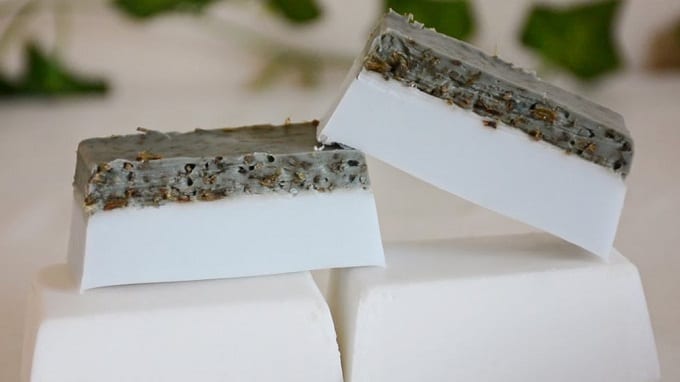
Few things entice you more than the scent of coconut and lavender—there’s just something about the way they mix together.
This recipe will likely be your favorite for the clean feeling, and natural fragrance that remains afterwards. You will need:
- 20 drops of lavender essential oil
- 32 oz of normal olive oil
- 16 oz of coconut oil
- 16 oz of grapeseed oil
- 24 oz of water
- 9 oz of lye
- Whisk
- Tea towel
Step 1
Put your water in a very large bowl, and then add the lye directly into it. Wait until it reaches about 110 F before you begin working with it.
Step 2
In a pot, mix all the oils you have together at once. Gently heat and whisk continuously, all while trying to reach the same temperature as the lye mixture. Be careful not to overheat your oils.
Step 3
Once all the oils are heated and mixed, blend them into the lye solution (not the other way around, because we don’t want the lye in the hot pot).
Get ready to pour the soap into a mould of your choosing.
Step 4
Pour the soap mixture into the mould, and cover it with a tea towel. You’ll want to leave this for three days, just like with our other soap recipe.
Step 5
After those three days, cut them into bars of your choosing. Because this is less volatile than our previous recipe, you only need to let them sit, or “cure” for about two weeks prior to use.
Related Questions
Is Lye Eco-Friendly to Use?
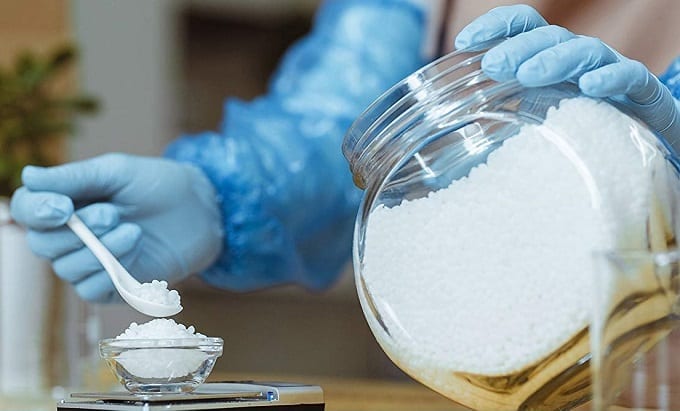
The way that lye is made nowadays isn’t natural, but that doesn’t mean it can’t be eco-friendly.
You know that curing method that we talked about? It actually changes the chemical composition of the lye, so it’s no longer harmful when introduced into nature.
That soap is going to last for a while and get washed down the drain, and when it does, you’re adding essential oils, olive oil, and relatively nothing else into the environment.
That’s not only fits with the biodegradable definition, but completely eco-friendly.
The production of any chemical is going to have a negative impact on the environment, but in your hands, you can transform it to something truly sustainable.
Lye basically makes the physical composition of soap more solid and sturdy, and will dissolve entirely in your soap.
How Dangerous is Lye to Use?
It can cause blindness, chemical burns that remove skin, and can be fatal if inhaled.
We can’t stress this enough, use protective gear when making soap. Lye is a necessary component in making any soap, and can’t be avoided.
If you make soap without lye, you’re doing one of two things:
- You’re just making a goop that is going to settle and won’t clean your skin properly.
- You’re reusing old, non eco-friendly soap to melt and mix together, which negates most of the reasons behind making eco-friendly soap in the first place.
Can I Include Any Essential Oil in Eco-Friendly Soap?
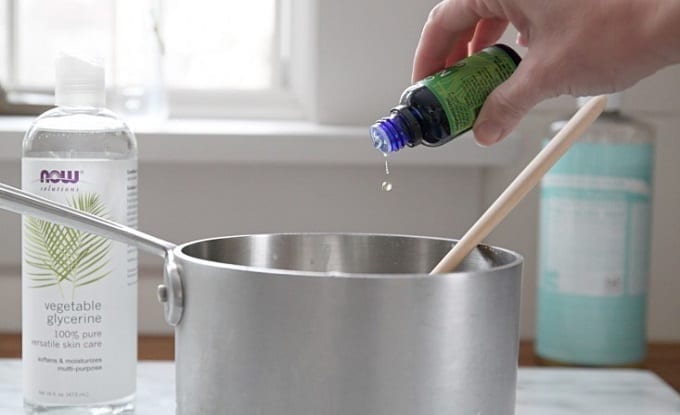
Yes, you absolutely can.
Essential oils provide benefits for your skin, but their compositions are basically the same no matter what.
You can choose between any essential oils for your soap production, though we did choose the ones in these recipes specifically for their calming properties.
For example, lavender has a strong scent and naturally relaxes you, and rosemary oil is absorbed into the skin very easily.
Can I Make Eco-Friendly Liquid Soap?
Eco-friendly liquid soap is an oxymoron.
In 2009, a Swiss study revealed that liquid soap, which was once thought to be more economically and environmentally sound, is actually worse for your wallet and the earth.
You’re likely to use more liquid soap without measuring it out properly, whereas with bar soap you apply it across your skin in a few strokes, and get the perfect amount.
On top of that, liquid soap is also far more expensive to create on your own.
Homemade liquid soap lacks many of the chemicals in commercial soaps. While we would normally argue about that being a good thing, it’s just not practical.
Homemade liquid soap comes out far more watery, and since it doesn’t stick around on your skin for the 20-30 seconds that is required to properly wash your hands, you’re not cleaning your hands as efficiently.
It’s good to be as environmentally conscious as you can be with soap, but not at the risk of contaminating food or surfaces in your home by not properly cleaning your hands and the rest of your body.

